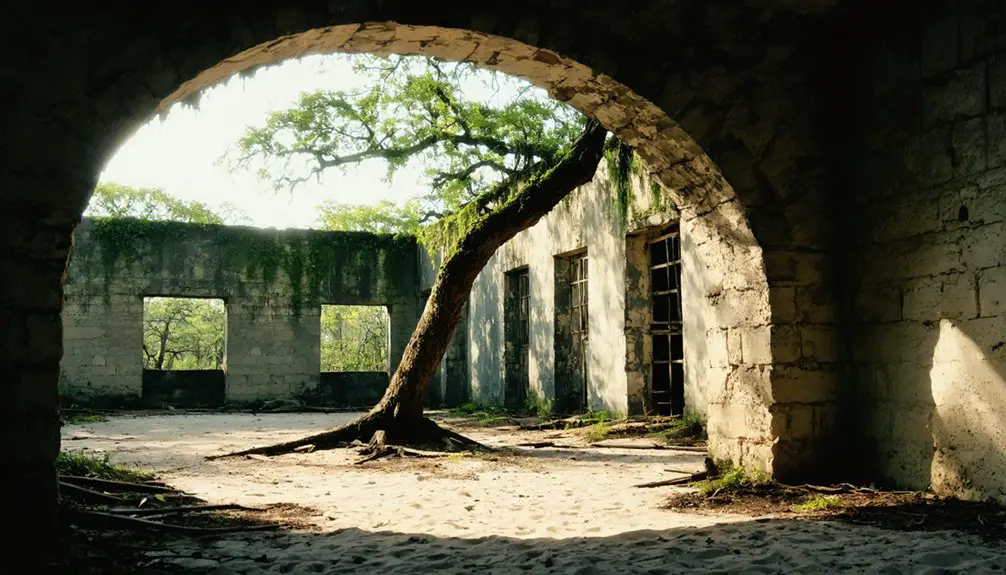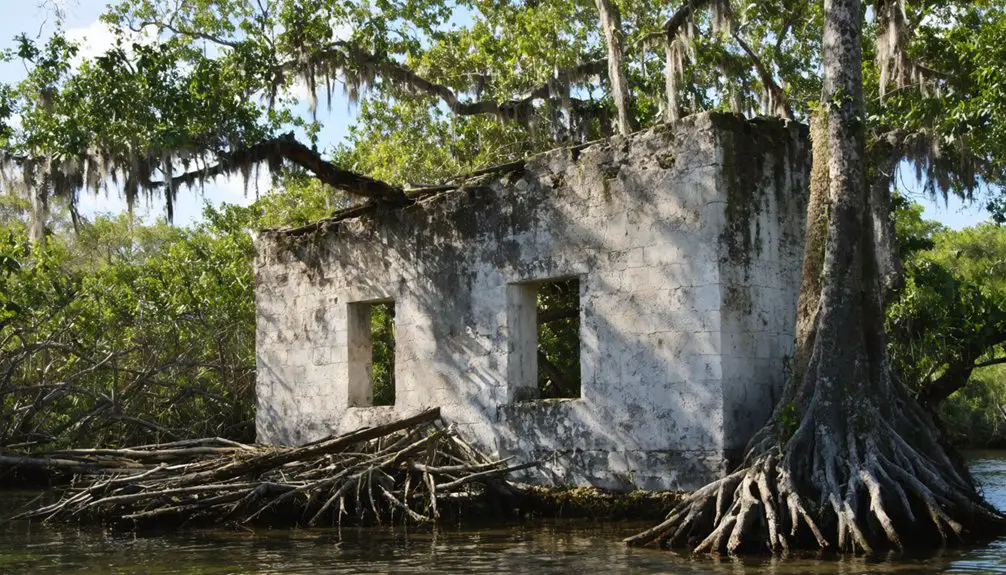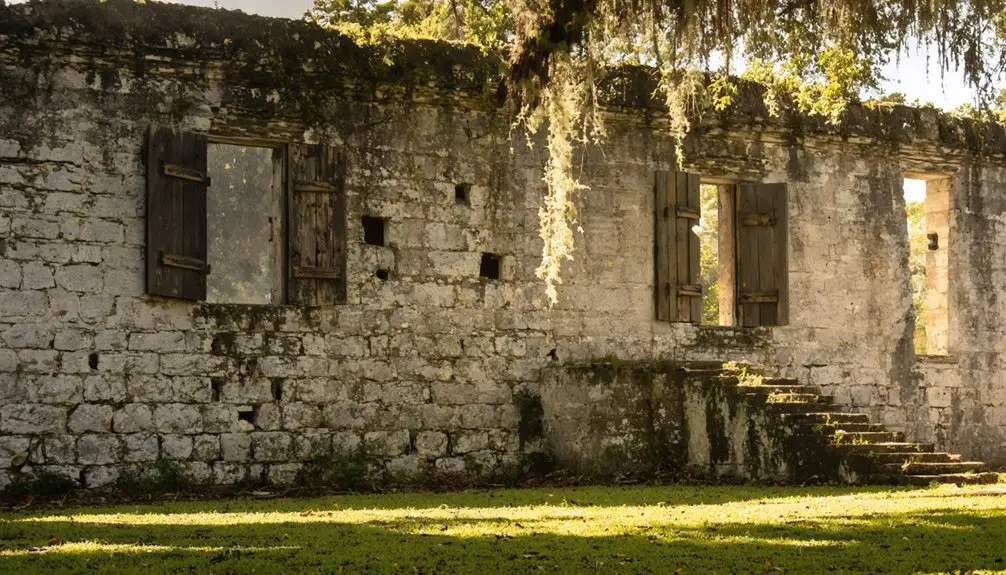You’ll find Fort Dallas‘s remains in modern-day Miami, where it began as a U.S. military outpost in 1836 during the Seminole Wars. The fort later transformed into William English’s plantation, operated by enslaved workers who constructed its distinctive limestone buildings. Though most structures vanished, you can still visit the preserved barracks at Lummus Park. This site’s evolution from military stronghold to ghost town mirrors South Florida’s dramatic transformation from frontier to metropolis.
Key Takeaways
- Fort Dallas transformed from a military outpost to plantation site before being largely abandoned after military operations ceased.
- The original settlement declined when troops relocated, leaving only stone structures as remnants of its military and plantation past.
- Only two original stone structures from 1844 survived: a rock mansion and longhouse, with the barracks relocated to Lummus Park.
- The site’s transformation from fort to ghost town occurred as civilian development shifted away from the original military settlement area.
- Archaeological findings reveal multiple abandoned uses of buildings, marking the site’s evolution from military post to deserted settlement.
Military Origins and Strategic Purpose
Founded in 1836 during the Seminole Wars, Fort Dallas emerged as an essential U.S. military outpost on Richard Fitzpatrick and William English’s plantation land in southern Florida. Under Lieutenant F. M. Powell’s initial command, the fort’s military strategy centered on controlling both inland approaches via the Miami River and maritime activities in Biscayne Bay. The fort’s original construction included two stone blockhouses for defensive operations.
You’ll find the fort’s strategic location served multiple purposes in troop logistics: disrupting Seminole supply lines, preventing trade between Native Americans and Cuban merchants, and protecting settlers. Later, the fort was commanded by Colonel William S. Harney, who further strengthened its military capabilities.
The installation incorporated existing plantation structures, converting them into defensive positions and barracks. The military established crucial infrastructure including a hospital, blacksmith forge, and trading post, while constructing roads to Fort Lauderdale to enhance regional control and troop movement capabilities.
Life at the Fort During Seminole Wars
The bustling military life at Fort Dallas revolved around a complex network of defensive structures and daily operations during the turbulent Seminole Wars period.
You’d find soldiers going about their daily routines within stone buildings and blockhouses, while wounded troops received care at the fort’s hospital. The trading post served as a hub where you’d see military personnel and settlers exchanging supplies and information. Guerrilla warfare tactics by Seminole fighters made the fort’s defenses crucial.
Inside the fort’s grounds, you’d witness diverse activities at facilities like the blacksmith forge, stables, and barracks. William English’s slaves constructed the original barracks building in 1849.
Daily life buzzed throughout Fort Dallas as soldiers worked and lived among the blacksmith forge, stables, and military quarters.
Soldier interactions extended beyond military duties as they contributed to regional development, constructing an essential road connecting Miami to Fort Lauderdale.
The fort’s strategic location along the Miami River enabled troops to monitor Seminole movements and protect settler interests while maintaining naval patrols that disrupted trade routes to Cuba.
William English’s Plantation Legacy
After purchasing the tract from his uncle Richard Fitzpatrick in 1843, William English established a significant plantation along the Miami River that would shape the region’s early development.
You’ll find his legacy most visible in the enduring stone structures built by enslaved workers – particularly the mansion and slave quarters that exemplified early masonry architecture in Miami.
The plantation economy he created marked a significant change from military to civilian settlement, though it relied heavily on slave contributions for its infrastructure and operations. His plantation cultivated one hundred acres of sugar using the labor of enslaved Africans.
While English’s pursuit of California gold in 1849 cut his time in Miami short, the buildings he commissioned became essential military assets when Fort Dallas was reoccupied, leaving an indelible mark on the area’s architectural and social history. The Army requisitioned Fort Dallas in 1849 to maintain a military presence in the region.
Notable Commanders and Military Operations
During its essential role in the Second Seminole War, Fort Dallas operated under several distinguished commanders who shaped its military significance in South Florida.
Lt. F.M. Powell established initial military leadership as the first commandant from 1836-1838, while Col. William S. Harney led strategic engagements including the notable 1840 attack against Seminole Chief Chakaika.
Gen. Thomas S. Jesup coordinated operations from the north to remove Seminoles from the region.
You’ll find the fort’s missions encompassed both defensive and offensive operations.
Beyond its role as a military outpost, Fort Dallas served as a vital supply depot and staging ground for troops.
The garrison coordinated Army-Navy operations to control South Florida’s waterways, prevent Seminole trade with Cuba, and support the broader campaign to subjugate indigenous resistance.
Named in honor of Commodore Alexander James Dallas, the fort played a crucial role in combating piracy along Florida’s coast.
Architecture and Construction Details
Beyond its military significance, Fort Dallas stands as a remarkable example of early South Florida architecture, built primarily from native oolitic limestone quarried directly on-site.
Fort Dallas exemplifies pioneering South Florida construction, its walls carved from local oolitic limestone extracted from the very ground it stands upon.
The one-story rectangular structure showcases construction methods that emphasize durability, featuring thick load-bearing walls and architectural features typical of mid-nineteenth century design. The building was established as part of Richard Fitzpatrick’s plantation before being converted to military use.
- You’ll notice the imposing recessed wood panel doors behind iron gates, a symbol of the building’s need for security.
- You can spot the exposed jig-cut rafters under the eaves, demonstrating skilled craftsmanship.
- You’ll find double-hung sash windows with protective iron grills, revealing the structure’s dual plantation-military heritage.
- You’ll observe the gable-style roof with interior brick chimneys, exemplifying the practical, robust construction philosophy.
The building’s design reflects a unique blend of military fortification and plantation architectural styles, adapted for South Florida’s climate.
From Military Post to Ghost Town
As Fort Dallas‘s military operations wound down in 1842, you’ll find that Colonel William F. English transformed the site into a plantation before abandoning it during the California Gold Rush of 1849.
You can trace the property’s subsequent evolution through multiple owners, including the Biscayne Bay Company’s trading post operations in the 1870s and Julia Tuttle’s agricultural ventures in the 1890s.
Within modern Miami’s urban landscape, you’ll discover that Fort Dallas’s remaining structures stand as silent witnesses to its change from a strategic military outpost to an abandoned settlement that helped shape South Florida’s early development.
Military Operations Cease
When military conflicts with the Seminoles subsided in 1842, Fort Dallas’s strategic importance diminished considerably, leading to the withdrawal of most U.S. troops from the installation.
The military withdrawal marked a significant turning point in the fort’s history, as its primary purpose of containing Seminole forces and preventing their trade with foreign vessels became unnecessary.
You’ll find these dramatic changes occurred during the troop relocation period:
- The once-bustling military reservation fell silent as soldiers departed for other assignments
- Colonel William F. English acquired the property, transforming it into a plantation
- Military structures were repurposed for civilian use, including county offices
- Trading posts replaced military operations, signaling the end of an era
Remnants Within Modern Miami
Despite the passage of time, remnants of Fort Dallas persist within modern Miami‘s urban landscape, offering tangible connections to the city’s military origins.
You’ll find two original stone structures that have withstood centuries of change: a rock mansion and a longhouse dating to 1844. Archaeological findings reveal that these buildings, constructed during William English’s time, served multiple purposes after the fort’s military operations ceased.
The most significant preservation effort occurred in the 1920s when local women’s clubs championed the relocation of the barracks building to Lummus Park.
This cultural heritage site, once surrounded by tropical fruit trees and positioned strategically along the Miami River, now stands as a rare symbol of Miami’s frontier past amid the city’s modern development.
Julia Tuttle and the Railroad Connection

Through relentless determination and strategic negotiation, Julia Tuttle played a pivotal role in bringing Henry Flagler’s railroad to Fort Dallas, which would soon become Miami.
Tuttle’s Vision centered on transforming this wilderness into a thriving metropolis by leveraging her extensive landholdings and the region’s unique climate. After moving from Cleveland due to financial hardship, she saw immense potential in developing the untamed Biscayne Bay region. She purchased significant acreage in the area after moving in 1891.
After the Great Freeze of 1894-1895 devastated northern Florida’s agriculture, Flagler’s Influence finally shifted southward.
- You can still see how Tuttle’s shrewd land deal – splitting her 640 acres with Flagler – sparked an urban revolution
- You’ll discover why sending frost-free citrus evidence proved essential to Miami’s birth
- You’ll understand how her persistence through countless letters and meetings finally paid off
- You’ll appreciate how her sacrifice of prime real estate guaranteed South Florida’s future
Preserved Structures and Modern Location
When you visit Fort Dallas today, you’ll find its most prominent preserved structure – the limestone barracks building – standing in Miami’s Lummus Park, where it was relocated in 1925 from its original downtown location.
The barracks, constructed of native oolitic limestone with distinctive iron-grilled windows and exposed rafters, represents one of only two surviving buildings from Miami’s earliest river settlement period.
Though the surrounding area has transformed from wilderness to urban metropolis, the building’s presence in Lummus Park continues to offer visitors a tangible connection to Miami’s military and pioneer heritage.
Barracks at Lummus Park
The historic Fort Dallas barracks, originally constructed as slave quarters on William English’s plantation around 1844, stands today as Miami’s oldest surviving military structure within Lummus Park.
When faced with demolition in 1925, local women’s groups spearheaded a remarkable preservation effort, dismantling and relocating the limestone building brick by brick via barge along the Miami River.
- The barracks represent Miami’s earliest civic preservation victory, protecting an essential piece of pioneer-era architecture.
- You’ll find native oolitic limestone construction that showcases early South Florida building techniques.
- The structure serves as a symbol of Miami’s complex military history during the Seminole Wars.
- Within Lummus Park’s historic district, you can explore this tangible connection to antebellum Florida.
Site’s Urban Transformation Today
Located within Miami’s District 2, Fort Dallas Park currently undergoes significant restoration initiatives that blend historic preservation with modern urban development.
You’ll find the Flagler Worker’s House as a key preserved structure, representing the site’s labor history and early development period. This urban renewal project, managed by Miami’s Office of Capital Improvements, focuses on enhancing site conditions while maintaining historical authenticity.
The transformation emphasizes walkability and community engagement, integrating the park with Downtown Miami’s broader revitalization goals.
You’ll notice how the site’s proximity to major urban hubs supports its evolution into a dynamic space that balances tourism, education, and local use.
The preservation efforts serve as a model for combining heritage conservation with progressive urban planning, ensuring Fort Dallas remains relevant in Miami’s modern cityscape.
Impact on Early Miami Development

Established as a military stronghold in 1836, Fort Dallas served as a crucial catalyst for Miami’s early development and urbanization. The fort’s presence shaped critical settlement patterns through infrastructure development and security provisions, laying economic foundations that would transform the frontier into a thriving urban center.
- You’ll find the fort’s strategic location fostered essential trade routes and transportation networks, connecting early settlers with important resources.
- The military post’s infrastructure investments, including roads, barracks, and a hospital, created the backbone for future civic development.
- Fort Dallas’s protection enabled settlers to establish permanent communities, breaking free from frontier constraints.
- The site’s shift from military post to administrative center demonstrates its role in Miami’s evolution toward independence and growth.
Frequently Asked Questions
What Happened to the Slaves After William English Left for California?
You’ll find limited post-emancipation life records or slave narratives documenting their fate, though historical evidence suggests they were likely returned to English’s mother in South Carolina after his 1849 departure.
Were There Any Archaeological Findings From the Original Fort Site?
You’ll be amazed – a treasure trove of archaeological discoveries exist, including military-era metal objects, musket balls, charcoal deposits, and historical artifacts like nails from the fort’s 1836-1857 occupation period.
Did Any Native Americans Ever Temporarily Occupy Fort Dallas?
You won’t find evidence of Native American temporary occupation at the fort itself – it remained under strict U.S. military control, though Seminoles were forcibly held there during relocation operations.
What Diseases or Epidemics Affected the Fort’s Inhabitants?
Menacing mosquitoes spread devastating yellow fever through your fort’s population, while smallpox swept through periodically. You’d also face dysentery, malaria, and typhus in the sweltering Southern conditions.
How Did Local Wildlife and Climate Impact Daily Operations?
You’d face constant wildlife interactions with dangerous alligators, snakes, and insects, while climate challenges like intense heat, flooding, and humidity damaged structures and complicated military operations and farming.
References
- https://hiddenhistorymiami.com/the-plantation-slave-quarters-2/
- https://www.legendsofamerica.com/fort-dallas-florida/
- https://en.wikipedia.org/wiki/Fort_Dallas
- http://www.historicpreservationmiami.com/pdfs/Fort Dallas.pdf
- https://www.ghosttowns.com/states/fl/fortdallas.html
- https://www.uflib.ufl.edu/spec/ingraham/expedition/Dallas.htm
- https://www.mycityhunt.com/cities/miami-us-11543/poi/fort-dallas-40297
- https://www.miami-history.com/p/fort-dallas-barracks-1849-to-present
- https://en.wikipedia.org/wiki/Seminole_Wars
- https://www.miami-history.com/p/history-of-fort-dallas-732



